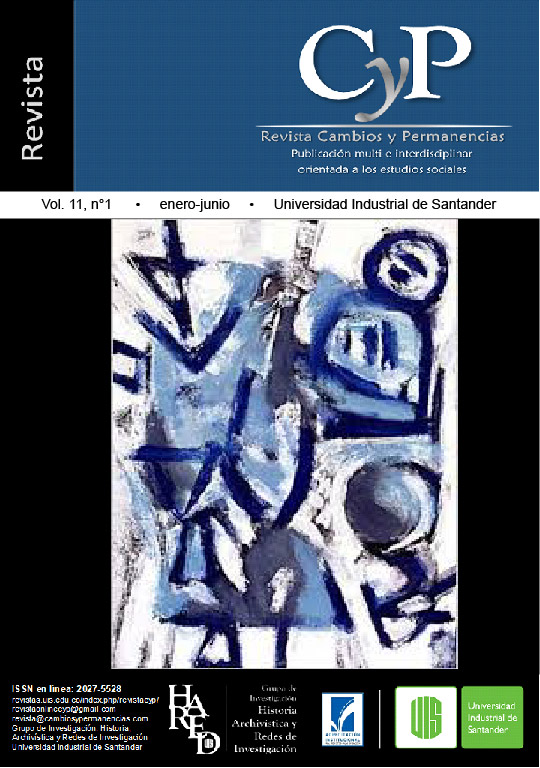Published 2020-06-30
Keywords
- Oral history,
- Cold War,
- political history,
- international relations,
- culture and dance
How to Cite
Abstract
This work draws on an oral history interview with a Mexican ballerina of modern dance, in relation to the tour she made with her troupe to the Soviet Union and China in 1957, when trips of this nature seemed inconceivable in the context of the Cold War.
This simple anecdote displays a web of social practices and representations that when contextualized, analyzed and interpreted historically, gives us a glimpse of the cultural battles that were fought over in a world divided into two blocks: communism and capitalism.
The oral story recorded, however an individual point of view, gives an entrance to the social history, since it incorporates values and codes that were elaborated an acknowledged within a community.
In addition, a singular story helps to understand the complex relation between individuals and structures. Institutions restrain social actors´ freedom to act but at the same time it is interesting to discover the tactics and strategies they improvise to try out new alternatives to survive. The scenarios presented in this particular case of study provide an opportunity to make political history and explore the history of international relations from a microsocial perspective, taking into account unconscious and conscious factors for the historical explanation.
Downloads
References
Dallal, A. (1994) La danza en México en el siglo XX. México: Consejo Nacional para la Cultura y las Artes.
Delgado, C. (1994) Guillermina Bravo. Historia oral. México: Instituto Nacional de Bellas Artes/Centro Nacional de Investigación, Documentación e Información de la Danza José Limón.
Deutscher, I. (1971). Sobre la revolución cultural china. Entrevista realizada por Ernest Tate por encargo de la revista italiana La Sinistra. En Deutscher, I. El maoísmo y la revolución cultural china. (Trad. J. L. González). México: Ediciones Era.
Iber, P. (2015). Neither peace nor freedom: the cultural cold war in Latin America. Cambridge, Massachusetts, EE. UU.: Harvard University Press.
Kennedy, P. (1988). Auge y caída de las grandes potencias. (Trad. J. Ferrer Aleu). Barcelona, España: Plaza & Janés Editores.
Maynes, M. J., Pierce, J. L., Laslett, B. (2008). Telling Stories. The use of personal narratives in the social sciences and history. New York, EE. UU.: Cornell University Press.
Meyer, L. (2004). La guerra fría en el mundo periférico: el caso del régimen autoritario mexicano. La utilidad del anticomunismo discreto. En D. Spenser. (coord.), Espejos de la guerra fría: México, América Central y el Caribe (pp. 95-117). México: Centro de Investigaciones y Estudios Superiores en Antropología Social/Secretaría de Relaciones Exteriores/Miguel Ángel Porrúa.
Monsiváis, C. (2010). La cultura mexicana en el siglo XX. México: El Colegio de México.
Morrison, S. (2016). Bolshoi confidential. Secrets of the Russian ballet from the rule of the tsars to today. Nueva York, EE. UU.: W. W. Norton & Company.
Nye, J. S. (2004). Soft Power. The means to success in world politics. New York, EE. UU.: Public Affairs.
Stone, L. (1986). El resurgimiento de la narrativa. Reflexiones acerca de una nueva y vieja historia. En L. Stone. El pasado y el presente. (Trad. L. Aldrete Bernal). México: Fondo de Cultura Económica.
Tristán, E. R. (2012). Estados Unidos y América Latina durante la Guerra Fría: la dimensión cultural. En B. Calandra., y M. Franco. (Eds.), Desafíos y límites para una nueva mirada de las relaciones interamericanas. Buenos Aires, Argentina: Biblos.
Hemerografía
Baroni, A. (1957). La Danza de las horas. Excélsior.
El Nacional (27 de julio de 1957). No ha mandado el INBA grupo artístico a Rusia. El Nacional.
Excélsior (26 de julio de 1957). El PNM demanda el cese del director del INBA. Excélsior.
Excélsior (27 de julio de 1957). Bellas Artes no envía bailarines a visitar Moscú. Excélsior.
Excélsior (29 de julio de 1957). Condena el Vaticano el Festival Internacional de la Juventud. Excélsior.
Excélsior (29 de julio de 1957). Inevitable el triunfo del socialismo. Excélsior.
Excélsior (30 de julio de 1957). Voroshilov se dirige a la juventud mundial. Excélsior.
Ingold, T. (2015). Conociendo desde dentro: reconfigurando las relaciones entre la antropología y la etnografía. Etnografía contemporánea., 2(2), 218-230.
Ryan, W. L. (6 de agosto de 1957). El Festival Soviético de la Juventud contraproducente. Excélsior.
Material de archivo
Archivo Histórico Genaro Estrada [AHGE]. (1958). Grupos mexicanos en gira por Europa, (Ballet Nacional Contemporáneo de México). Archivo Histórico Genaro Estrada, AHGE. México: Secretaría de Relaciones Exteriores. Archivo de la Embajada de México en la URSS, Legajo 10, Expediente 5, 51 fs.
Entrevistas
Primera entrevista a Castro, V. Realizada por De Garay, G., Lacarrieu, M., y Ramírez, R. (22 de noviembre de 2017). Proyecto Historia oral de la danza en México (1950-2018), Ciudad de México, México: Instituto Mora PHO 24/1(1).
Segunda entrevista a Castro, V. Realizada por De Garay, G., Bastien, K., y Ramírez, R. (11 de abril de 2018). Proyecto Historia oral de la danza en México (1950-2018), Ciudad de México, México: Instituto Mora PHO 24/1(2).

